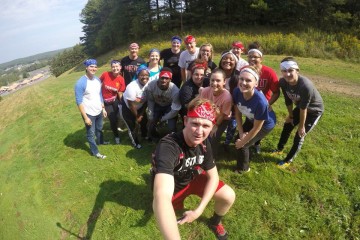Student Develops Interactive Real-time Media Streaming
Streaming video has become interwoven into our lives. Netflix, Hulu Plus, Amazon and HBO all compete for viewers’ attention on every device with a screen. Movies are now available a click away.
Most viewers expect to view and share this content with friends. Those with electronic devices are seen gaming, chatting and video conferencing together all at once. The internet has brought people closer together and currently, Frostburg State University (FSU) is taking the opportunity to create closer student and the community connections online.
Alongside Assistant Professor Xunyu Pan, FSU student Kevin Free has been developing just that. He created a real-time multimedia application to allow viewers to watch movies together half a world away, or down the hall. The research looked very promising and then over the summer, Free completed a manuscript to be submitted to the SPIE EI 2014 conference.
The SPIE conference draws a crowd of more than 1000 people from all over the world. SPIE conferences cover a range of topics from defense and security to remote sensing and scanning microscopes. Innovators and pioneers in their fields will be presenting research and developments that could potentially change the way we communicate and interact with each other on a global scale.
Kevin Free will be shoulder to shoulder with those developing the very cutting edge. He was chosen to give an oral presentation, an honor usually reserved for PH-d students and professors from University of Berlin, University of Delaware, Telcom SudParis and many other prestigious research labs.
These labs are doing some of the leading work for companies such as Samsung and Nokia. It is a great honor that FSU’s own student will be counted among these innovators. Free will be delivering his presentation at the 26th SPIR conference for Electronic Imaging. The presentation will be on February 2 and demonstrations on February 4.
All are encouraged to attend. More than $10000 in funding has been provided by the National Science Foundation and FSU president’s Experiential Learning Enhancement Fund Program or the PELEF for short, the FSU Foundation Opportunity Grant and a list of others.
Free has become an inspiration, showing what is possible at the undergraduate level. His start in COSC 331 and progression to COSC 345 has progressed his research from the classroom to the world’s stage. At this rate, he may join in the ranks of Sir Tim Berners-lee at the World Wide Web consortium.
What started as a class assignment with the guidance and influence of Pan could potentially change the way people communicate and interact online. This creation shows that the advancements developed at this level are very much relevant to the world.
The concept of the software is to have a peer-to-peer sharing of a video file with both parties able to interact and control the media. The logical structure is divided into three components or layers that could almost relate to the OSI model. This would transmit the data between the local end system and the other connected party and to control the interactive features.
The media interpretation is the section of the program that would compress and decompress media for transmission to allow smooth streaming between parties. The social communication component would allow users to be as connected as if they were viewing movies with a friend in their home. This development allows users to share the social experience of viewing media no matter where they are.




